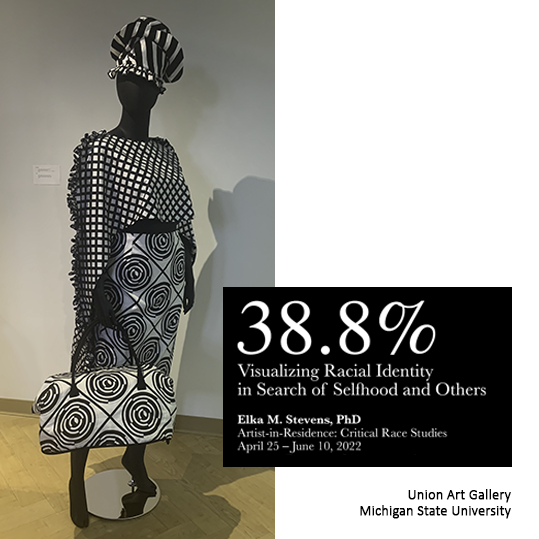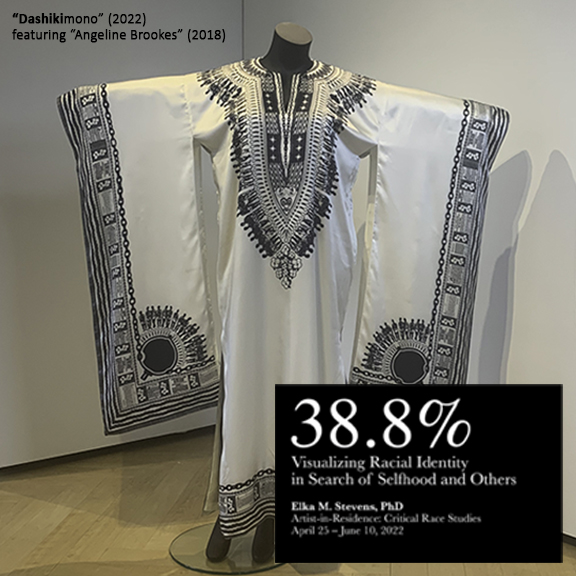"38.8%: Visualizing Racial Identity in Search of Selfhood and Others"

Please join the MSU Department of Art, Art History, and Design at The Union Art Gallery on Michigan State Universities' Campus for 38.8%: Visualizing Racial Identity in Search of Selfhood and Others, featuring the work of 2021-2022 Artist-in-Residence: Critical Race Studies, Dr. Elka Stevens. This exhibition is on view Monday, April 25 – Friday, June 10, 2022. In 38.8%, artist and designer Elka Stevens visually interrogated aspects of race, ethnicity, nationality, genetics, and their presentation as part of identity. Although many aspects of identity are out of people’s control and largely unseen, clothing allows individuals and groups to communicate messages about themselves, their cultures, activities, events, locations, and employment. Using textiles and clothing as a primary vehicle to present ideas about race, Stevens presented a mini-collection of stylized, wearable garments for women and selected artifacts that engage both the viewer and wearer in a dialogue about race and identity that explores how we wear our identities. Featured garments and accessories included dresses, a skirt, and a wrap. A quilt and blanket also narrated the social and physical attributes of race. The designs incorporated sewing techniques, such as embroidery, quilting, and applique. Surface design techniques displayed aspects of genealogy research into the collection. Archival research and imagery also contributes to the works, through motifs that include a family charts document and present wearable family histories. Color, along with other elements of design and their guiding principles, brought attention to an articulated genetic makeup. In sum, 38.8% was a re-presentation of a lived experience through worn and displayed objects.
Read the new interview, "Finding Herself Sqaurely in Afrofuturism" to learn more about the artist and her exhibition. It can be accessed here!
38.8% Music Playist
Enjoy the Spotify playlist that accompanies the show. Warning: Explicit content.





38.8% Reading List
If books are your preference, consider the following books and articles for reading pleasure:
|
BOOKS |
||||
|
|
A Hidden Chapter from the Eighteenth-Century Invention of Race (2022) by Henry Louis Gates Jr. and Andrew S. Curran (eds.) |
|
|
|
|
|
|
|
|
|
|
|
|
|
 Ain't I A Woman?: Black Woman and Feminism (1987) by bell hooks) |
 The Social Life of DNA: Race, Reparations, and Reconciliation After the Genome (2016) by Alondra Nelson |
|
FASHION BOOKS |
||||
|
|
|
|
|
|
ARTICLES
·
Coates,
Ta-Nehisi. (2014). The Case for Reparations. The Atlantic.
·
DiAngelo, Robin.
(2017). Why It's So Hard to Talk to White People About Racism. Huffington
Post.
·
McIntosh,
Peggy. (1989). White Privilege: Unpacking the Invisible Knapsack. Peace
and Freedom.
·
Serwer,
Adam. (2020). The Coronavirus Was an Emergency Until Trump Found Out
Who Was Dying. The Atlantic.
More Resources:

















